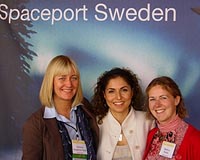 |
Canberra, Australia (SPX) Nov 03, 2009 The 2009 Australian Prime Minister's Prize for Science has been awarded to astronomer/engineer Dr. John O'Sullivan. The award and $300,000 grant recognizes Dr. O'Sullivan's contributions to astronomy and to the invention which made wireless computing fast and reliable. While looking for exploding black holes Dr. O'Sullivan created a technology that cleaned up intergalactic radio waves. Then in 1992, he and his colleagues at CSIRO realized that the same technology was the key to fast reliable wireless networking in the office and home. Their patented invention is now built into international standards and into computers, printers, smart phones and other devices used by hundreds of millions of people every day. It's one of the most significant achievements in CSIRO's 83 year history and illustrates how blue sky research can have very practical outcomes. Professor O'Sullivan is now working on the design of the Australian Square Kilometre Array Pathfinder telescope - a step towards the giant Square Kilometre Array which will be able to look back 13 billion years, almost to the Big Bang. Nearly a billion people use John O'Sullivan's invention every day. When you use a Wi-Fi network-at home, in the office or at the airport-you are using patented technology born of the work of John and his CSIRO colleagues. They created a technology that made the wireless LAN fast and robust. And their solution came from John's efforts to hear the faint radio whispers of exploding black holes. Today John is working on technology that will allow us to look back almost to the beginning of time itself. For his achievements in astronomy and wireless technologies John O'Sullivan receives the 2009 Prime Minister's Prize for Science. In 1977 John O'Sullivan co-wrote a paper about the use of a set of mathematical equations known as Fourier transforms to sharpen optical telescope images distorted by the atmosphere. The paper is short and, like O'Sullivan, somewhat humble. It builds on first principles of physics, but brings together a broad view joining radio and optics. And the paper is seminal. It explains the techniques known as adaptive optics and proves why they work. What's truly remarkable is that the consequences of that paper are now at work in millions of homes, airports, cafes, offices, hotels and universities across the world. They have cut the cables that tied computers to the desk and turned laptops into ubiquitous social and business tools... Amongst John's many research interests was the search for radio waves from exploding black holes-predicted in 1974 by Stephen Hawking. John didn't find them, but the techniques he and his collaborators developed to clean up intergalactic radio wave distortion eventually found expression as the technology in the wireless LAN. Share This Article With Planet Earth
Related Links Science in Public The latest information about the Commercial Satellite Industry
 Spaceport Sweden Working Side By Side With Spaceport America
Spaceport Sweden Working Side By Side With Spaceport AmericaLas Cruces NM (SPX) Oct 29, 2009 In January 2009 Spaceport Sweden and Spaceport America signed an MOU (memorandum of understanding) with the aim to develop in parallel as sister spaceports. This past week representatives from the two spaceports met again and attended several most successful working meetings. A large team from Spaceport Sweden visited Las Cruces in New Mexico to confirm this important relationship as well ... read more |
|
| The content herein, unless otherwise known to be public domain, are Copyright 1995-2009 - SpaceDaily. AFP and UPI Wire Stories are copyright Agence France-Presse and United Press International. ESA Portal Reports are copyright European Space Agency. All NASA sourced material is public domain. Additional copyrights may apply in whole or part to other bona fide parties. Advertising does not imply endorsement,agreement or approval of any opinions, statements or information provided by SpaceDaily on any Web page published or hosted by SpaceDaily. Privacy Statement |